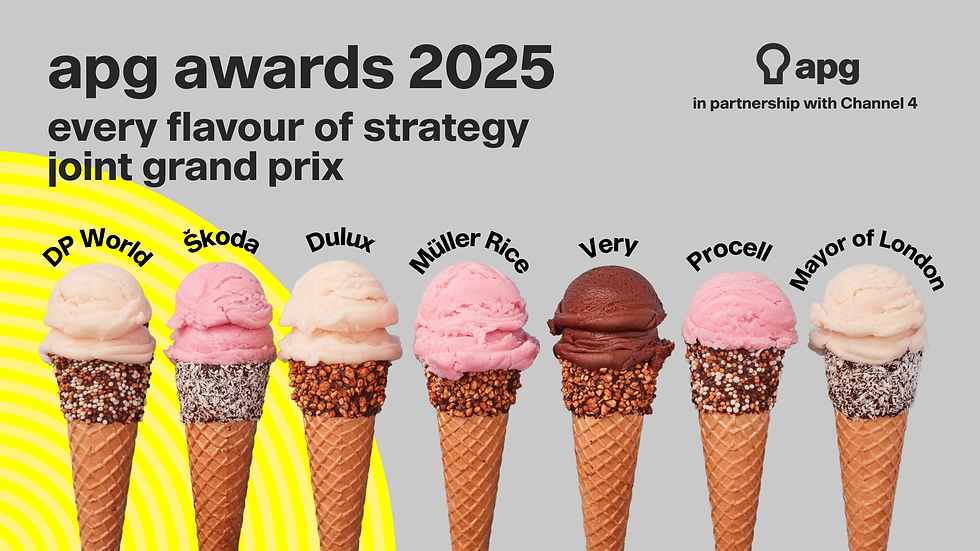A Suit’s Perspective
- APG

- Oct 18, 2017
- 4 min read
This is part of a series of posts selected by Jim Carroll, our APG Guest Editor during October 2017, surrounding the theme of
'How To Get On: Advice on how to manage a strategist’s career in a creative business'
Read more posts here

My credentials for commenting on this topic are as follows: First - I know Jim. Second, I started at one company, BBH, as a graduate trainee and left that same company some time later as Global CEO.
This could lead one to conclude that a fairly passive approach to career management, perhaps best described as: ‘sit tight, don’t leave – they will promote you eventually,’ is what is required. I suspect this is not what Jim is looking for. So, this being a planning forum, and me being an account man… I will make a list and divide it into three sections, a couple of tips for three stages of your career.
Stage 1. Getting Started
1. Deal in facts not opinions. Most meetings in agencies are an exchange of opinions, a succession of sentences starting with the phrase ‘What I think.” If you are the most junior person in the room, your opinion might not yet count for quite as much as everyone else’s in the judgement of those around you. So, deal in facts. And don’t dive in. Be circumspect, wait your turn (no one likes a smart arse). But bring real knowledge to the table and people will be seeking your opinion before you know it.
2. You’ve got three things to worry about: external relationships; internal relationships; and your work. That is also the right order of priority for dealing with them. Your work – the stuff you do at a desk on your own – comes last. The good news is, if you manage your relationships well, other people do a surprising amount of work for you. Half an hour spent with a creative team talking about how great their work is (no, really) might not feel as valid as the questionnaire you have to go through. But do it, do the questionnaire later, and then, when there is a real crisis, that team will get you out of trouble.
Stage 2. Getting Set
1. Understand the culture of your workplace. Agencies are people businesses. Culture really matters. Companies with good strong cultures like to preserve that when they can, by promoting from within. So, make sure you are in the right place for you. Ask yourself: Do I want to be here for a long time? Do I like, admire, respect the leaders of my discipline and my company? Do I want to be a leader here? If you can’t say ‘yes’ to those questions, try to get somewhere where you can. Easier to say than do perhaps, but worth it - it’s your future you are investing in.
2. If you are clear that you are in the right place, then don’t spend too much time worrying about, or managing, your career. Do your job well and your career will follow. Sometimes not immediately, but if you are in the right place, play the long game. People who make demands in the name of their career progress can become problems for management. I was confronted many times by people who told me they were ‘now ready’ to be Planning Director, or MD, or whatever. Which was great. But they rarely had a solution for the current incumbent of said position. And that could come across as a bit self-centred, rude even.
Stage 3. Getting to the Top
1. Be Positive. Seems trite to say, but don’t knock it. Some of the most successful people I know, who have made it to the top of this industry and beyond, were characterized less by being the smartest person in the room, and much more by being the most relentlessly positive. You might imagine that this matters more at junior levels – ‘can do attitude gets on’ - but I think it matters more for leadership. Wisdom goes further with positivity.
2. Understand that the best leadership is selfless. We live in an age of the cult of leadership. We analyse it and obsess about it. For good reason, no doubt. More, better leadership is normally a good thing. But leadership cults don’t normally end well, and one-dimensional notions of what great leadership looks like aren’t helpful. We tend to characterize leadership with metaphors from battle and sport – it is all about leading from the front. But some of the best leadership I have witnessed has been the opposite. Sarah Thompson, Worldwide CEO of Droga 5, practises a quiet leadership, pushing others forward, leadership from behind if you will. Nigel Bogle used to quote the line: ‘There is no limit to what we can achieve as long as we care not who gets the credit.’ It’s not about you. It’s about them.
And, if all else fails, remember the John Bartle rules of good agency leadership behaviour:
Always smile
Never run
At that moment at an agency party when it is all about to really kick off and go to the next level…. leave.

Gwyn Jones
Chairman of Quill Content, Bloom & Wild. Partner of Carroll Jones, and Former CEO of BBH
For the best part of twenty-five years Gwyn was my work partner at BBH. He looked after me through good times and bad. Without him I wouldn’t have had a career. So I’d suggest his panoramic view of ‘how to get on’ is worthy of particular attention.
- Jim Carroll




Comments